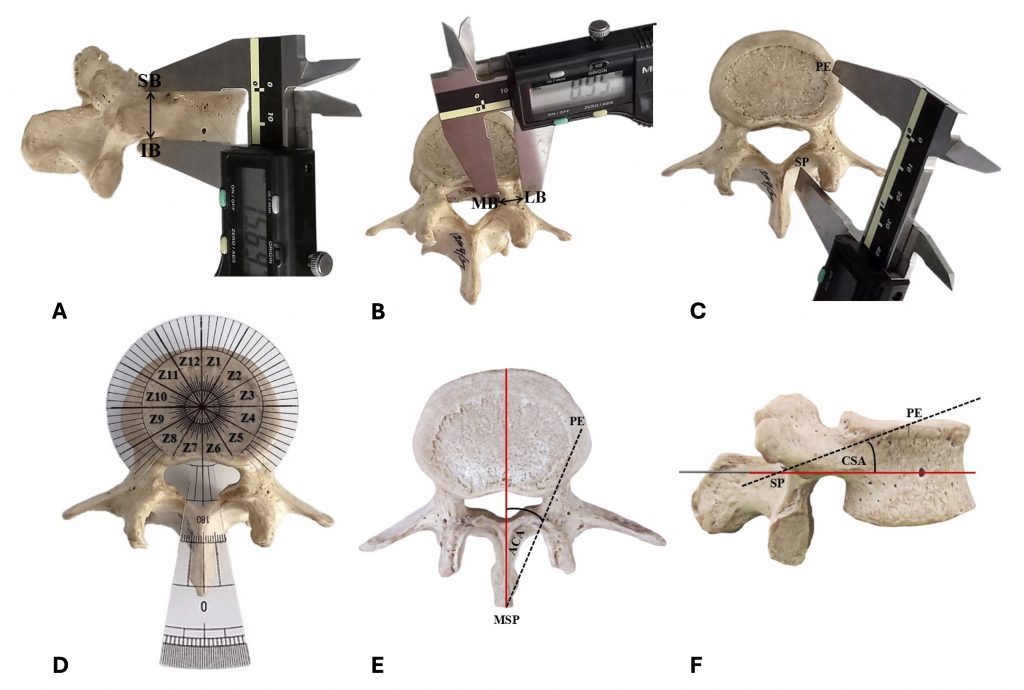Highlight
การศึกษานี้สำรวจข้อมูลมอร์โฟเมตริกของกระดูกสันหลังส่วนเอวในประชากรไทยภาคตะวันออกเฉียงเหนือ พบความแตกต่างด้านขนาดและมุมของกระดูกระหว่างเพศและข้างซ้ายขวา ข้อมูลนี้ช่วยสนับสนุนการออกแบบและพัฒนาสกรูที่เหมาะสมสำหรับการใช้งานแบบ cortical bone trajectory ในผู้ป่วยไทย

ที่มาและความสำคัญ
โครงสร้างกระดูกสันหลังส่วนเอว (lumbar vertebrae) มีความสำคัญต่อการรองรับน้ำหนักตัว รักษาเสถียรภาพ และป้องกันไขสันหลัง การศึกษานี้เน้นการวิเคราะห์ลักษณะโครงสร้างกระดูกในประชากรไทยภาคตะวันออกเฉียงเหนือ เพื่อใช้เป็นข้อมูลพื้นฐานสำหรับการวางสกรูแบบ cortical bone trajectory (CBT) ซึ่งเป็นเทคนิคใหม่ที่ลดความเสี่ยงของการหลวมและการเกิดปัญหาทางกระดูก โดยมีการวัดความสูง ความกว้าง และมุมของกระดูกสันหลัง พบความแตกต่างระหว่างเพศและข้างซ้ายขวา ข้อมูลนี้มีประโยชน์ต่อศัลยแพทย์กระดูกในการออกแบบและใช้สกรูที่เหมาะสมในผู้ป่วยคนไทย
Abstract
Study Design
Retrospective cohort study.
Purpose
This study aimed to explore the morphometry of the Thai lumbar vertebrae.
Overview of Literature
The cortical bone trajectory (CBT) is a novel approach for vertebral screw fixation aimed at addressing spinal instability associated with spinal disorders. The morphometry of the lumbar vertebrae is crucial in tailoring screw design for each CBT application, given the significant variations in optimal screw sizes, lengths, and angles among populations.
Methods
A total of 300 dried lumbar columns were used to measure the pedicle height (PH) and width (PW), length for cortical bone trajectory (LCT), cephalad screw angle (CSA), axial cortical bone trajectory angle (ACA), and possible cortical zones for the CBT.
Results
The following average values were calculated: PH in L1, 15.09±1.44 mm; PW in L5, 16.96±2.42 mm; LCT in L3, 35.75±2.61 mm; CSA in L1, 20.85°±2.30°; and ACA in L5, 21.83°±2.49°. Women generally had shorter PH and PW than men, with significant differences across lumbar levels. The LCT was significantly shorter in women and was notably different between the left and right sides. The CSA and ACA varied significantly between sexes and sides, with specific lumbar levels showing wider angles in one sex over the other. The most common cortical zones for screw tips were Z3 and Z10, with high incidences across all lumbar levels.
Conclusions
This study presents detailed lumbar vertebral morphometry data specific to the Thai population. The results are essential for CBT application in screw fixation procedures. This information will contribute to the production of optimally designed screws for Thai patients in the future.
KEYWORDS: Lumbar vertebrae, Lumbosacral region, Spine
Citation: Hanarwut, P., Iamsaard, S., Paholpak, P., Wisanuyotin, T., Kasai, Y., Yurasakpong, L., Suwannakhan, A., & Chaiyamoon, A. (2024). Exploring cortical trajectory of the lumbar vertebrae: A morphometric study in dry skeletons: A retrospective study in Thailand. Asian Spine Journal,18(5):654-662.
DOI: https://doi.org/10.3390/biomedicines12030659
RELATED SDGs:
3. GOOD HEALTH AND WELL-BEING

ผู้ให้ข้อมูล: ผู้ช่วยศาสตราจารย์ ดร.อธิคุณ สุวรรณขันธ์
ชื่ออาจารย์ที่ทำวิจัย: อาจารย์ ดร.ลภัสรดา ยุรศักดิ์พงศ์, ผู้ช่วยศาสตราจารย์ ดร.อธิคุณ สุวรรณขันธ์
Credit ภาพ: ผู้ช่วยศาสตราจารย์ ดร.อธิคุณ สุวรรณขันธ์
Webmaster: ว่าที่ ร.อ. นเรศ จันทรังสิกุล
Tags: Lumbar vertebrae, Lumbosacral region, Spine
